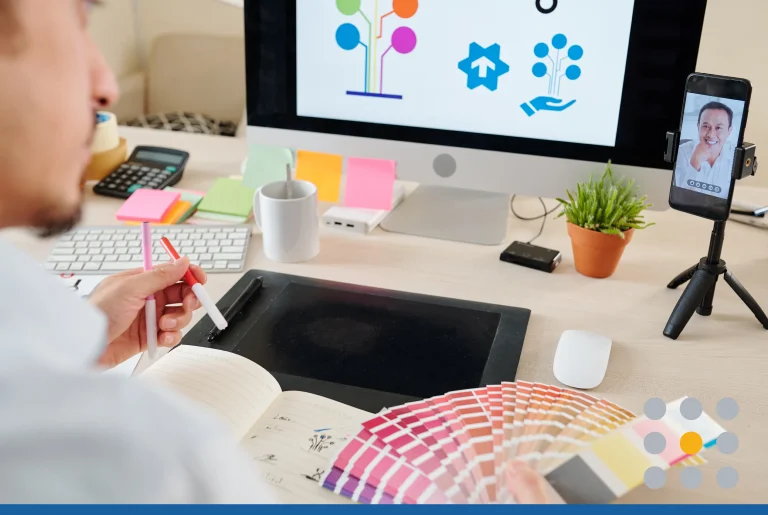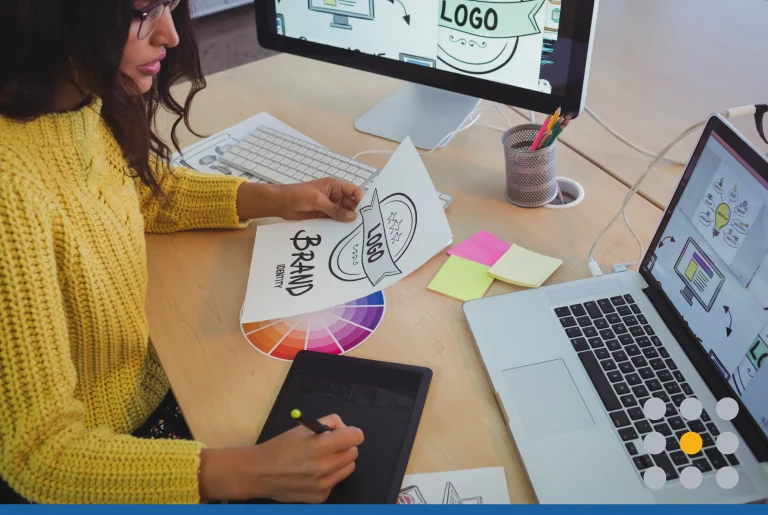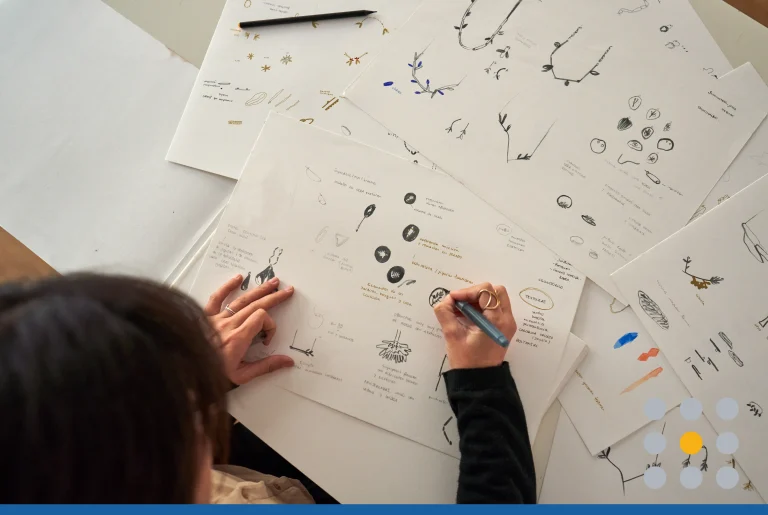Your business’s logo has a huge impact on the way your brand is perceived. Not only is your logo a major identifier of your business, but it can make you seem more or less professional and influence the success of your business for years…or at least until you finally go for that redesign.
Today, creating a logo doesn’t necessarily require formal education in graphic design. Thanks to the myriad of tools and resources available online, you can create your business’s logo yourself. But whether you hire a graphic designer or decide to create your business’s logo, it’s important to make sure your logo is the right size.
So, what size should a logo be? The answer isn’t exactly black and white.
Logos are used for many applications, from websites and letterheads to social media and email blasts. And because each requires a slightly different presentation and dimensions, the idea of a standard logo size is kind of a misnomer.
But don’t worry. There are best practices and concepts to keep in mind when it comes to logo sizes and logo design, and for the most part, a properly designed logo can be adapted to just about any use.
Read on to learn the basics of logo sizes and the easy way you can ensure your logo fits any application.
Logo Guidelines: Pixels, Points, and Inches
When most people look at a screen, magazine, or newspaper, they see text and images. But designers understand that everything you see is made up of tiny dots.
On computers and the web, they’re called pixels, and millions of them—over two million for a standard 1080p panel—form the basis of everything you see, from the text you read, to the images that inspire you.
But the problem with pixels is that they don’t scale, and 100 pixels on your cell phone is going to look a lot different than 100 pixels on your laptop. That’s because the size of any image depends on the number of pixels per inch, or PPI, of your devices.
Points are a way to balance the different densities and pixels that make up our various screens, which gives a more accurate representation of the physical size of any specific image.
Specifically, a point is 1/72 of an inch, which corresponds to the longstanding web PPI of 72. This is far short of common print dots per inch, or DPI, of 300. It all has to do with resolution and is part of the attempt to standardize sizing in the digital realm. But by using pixels, points, and inches, designers can send work back and forth with consistency, if they’ve prepared their images in the right way.
The Importance of Vectors
When it comes to logo design and logo sizes, it’s important that you create your design using vectors, rather than pixels.
Pixels are fixed to a specific size and won’t scale without causing pixelation—you know, those annoying fuzzy edges on what was once a crisp, sharp image.
Vectors are made of shapes with corresponding color information. This enables a logo made from vectors to be scaled both up and down with no loss in sharpness. This means that an email logo, website logo, and letterhead logo can all be created from the same source logo with minimal work.
A raster logo, or a logo encoded as pixels or points, can only be resized down, making it difficult (and sometimes impossible) to print or otherwise use a logo from your website.
Aspect Ratios: Horizontal, Vertical, and Square
If you’re looking for standard logo size, you’re better off thinking about it as aspect ratio, or the horizontal versus the vertical size of your logo.
A square is a perfect 1:1, meaning that the number of vertical pixels is equal to the number of horizontal pixels. Logos of this size are common on social media and the web.
The beauty of aspect ratio is that you can go with whatever ratio you’d like. Want a tall logo that’s twice as high as it is long? No problem, as long as it fits your design constraints and the medium your logo will be placed in.
For mobile devices that are typically used in portrait mode, vertical designs and logos are great. This also goes for magazines and pamphlets that have more vertical real estate than horizontal. For laptops and desktop computers, or where content is primarily consumed in landscape mode, a logo that’s wider than it is tall might be a better bet.
For these reasons and more, most logos today are square (or square-ish). Because square logos look better on more devices and orientations, it’s easier to stick with one universal design than to support a host of different logos for each platform.
Logo Sizes for Social Media
![]()
Whether or not your logo is going on your website or a social media profile, you will likely have to resize or adjust your existing logo to suit. While you might be tempted to upload your logo as is, each social platform has its own rules when it comes to dimensions. This can include specific filetypes and file size limitations, and you’ll likely end up with a stretched or distorted logo if you don’t take the necessary precautions.
Before you prepare a logo for social media, you’ll have to determine the size and formatting accepted by the platform. Usually, these are shown in pixels such as 170×170, meaning that the image is 170 horizontal pixels and 170 vertical pixels, a perfect square.
Keep in mind that logo size requirements for social media change frequently, so you’ll want to check for updates from time to time. For quick reference, here are links to many common logo size requirements across popular social networks.
Facebook Logo Size Requirements
Facebook has different logo size requirements for personal pages versus business pages. Depending on the type of account you have, keep these logo size requirements and other best practices in mind.
For personal pages, profile pictures display at:
- Computers – 170 x 170 pixels
- Smartphones – 128 x 128 pixels
- Most feature phones – 36 x 36 pixels
For personal pages, cover photos display at:
- Computers – 820 x 312 pixels
- Smartphones – 640 x 360 pixels
- Note: These images should be at least 400 x 150 pixels for best results
For business pages, keep these photo sizes in mind:
- Profile images – 320 x 320 pixels
- Cover images – 720 x 312 pixels
- App images – 111 x 74 pixels
- Newsfeed images – 1,200 x 628 pixels
- Page like ads on desktop – 1,200 x 444 pixels
- Page like ads on sidebars – 254 x 94 pixels
- Page like ads on mobile – 560 x 208
Instagram Logo Size Requirements
When sharing an image to your Instagram feed, the app will keep the image’s original resolution if the image’s aspect ratio is between 1.91:1 and 4:5. This translates to a height between 566 and 1,350 pixels with a width of 1,080 pixels.
Twitter Logo Size Requirements
Can’t say what you want to say in less than 280 characters? Luckily, Twitter is a little more flexible when it comes to images—just keep these logo size requirements and aspect ratios in mind.
- Profile images – 400×400 pixels
- Banner images – 1,500 x 500 pixels
- 91:1 aspect ratio – 800 x 418 pixels
- 1:1 aspect ratio – 800 x 800 pixels
LinkedIn Logo Size Requirements
- Profile images – 300 x 300 pixels
- Banner images – 1,192 x 220 pixels
- Main images – 1,128 x 376 pixels
- Custom modules – 502 x 282 pixels
- Company photos – 264 x 176 pixels
YouTube Logo Size Requirements
- Cover images – 2,560 x 1,440
- Channel icon – 800 x 800 pixels
Keep in mind that you’ll want to match the pixel sizes exactly for the best image resolution. This means creating a unique logo export for each platform and use. Not sure where to start? Check out our helpful tips on how to make a logo for social media.
Website Logo Size, Email, and Print

Unlike social media profiles that require exact aspect ratios and pixels, logos used for your website, email blasts, or in print are much more flexible, if you follow the vector rules above.
In these instances, the proper visual effect, sizing, and spacing is more important than hitting a specific pixel count, so you have greater flexibility when it comes to these uses of your logo.
For the web, including email logos and other uses outside of social media, we recommend going with what looks appropriate for the medium.
If this is for your mobile site, size it appropriately for the elements on your page and pull it up on a few different devices to see how it looks.
For print, it depends on the specific job. Printing a billboard requires a logo and imagery significantly larger than a letterhead, even if they both use the standard of 300 DPI. For this reason, it’s important to use a vector image that scales well in both directions. The best logos look great small and large, and for this reason most logos for top brands are simplistic and cleanly designed.
The best logos fit the many different needs of business and work well on a business card and on a 40-foot billboard. That’s the mark of good design!
Learn More About Logo Sizes at FreeLogoServices
If the talk of standard logo sizes—which aren’t really standardized at all—feels like a lot, FreeLogoServices can help.
Our user-friendly website allows you to easily create a logo for free and add on a Social Media package to your purchase to take the extra work out of tricky sizing details. Simply choose your design and we will supply you with the correct filetypes and aspect ratio. You can even take your image offline into any professional image editor for further tweaks, like cropping or resizing. Our easy-to-use logo editor means you can have a professional logo in just minutes, versus weeks of planning and discussions with a professional designer. Our website builder also allows you to make your own custom website in just a few quick clicks, or you can work with a designer to make your logo really shine.
We guarantee you’ll love your logo and will have the proper logo sizes to use in any situation.







